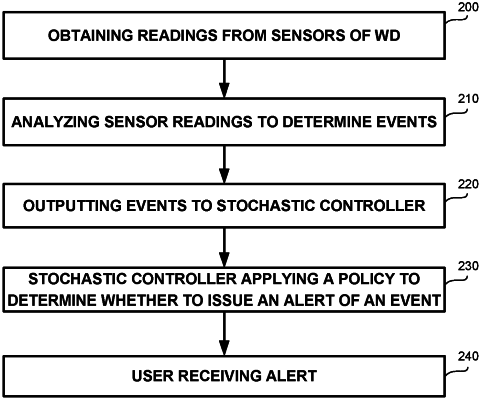| CPC G06N 7/01 (2023.01) [G06F 1/163 (2013.01); G06F 3/011 (2013.01); G06F 3/0481 (2013.01); G06F 9/542 (2013.01); G08B 21/043 (2013.01); G08B 21/0446 (2013.01); G08B 21/0453 (2013.01); G08B 21/12 (2013.01)] | 21 Claims |

|
1. A computer-implemented method comprising:
receiving derived events indicative of potential notification to the user from an analysis component comprising an analytics lab of a modular platform, wherein the derived events are generated using complex event processing of the events generated from multiple sensor readings of one or more sensors of a wearable device and a sensor not mounted on any wearable device;
determining, by a notification component of the modular platform comprising a stochastic controller that is independent of the analysis component, whether or not to provide one or more alerts to a user in any future timeframe based on the derived events and based on a user preference, wherein the analysis component does not process previous event notifications, wherein the one or more alerts are configured to alert the user that respective events of the events have occurred, wherein the user preference is indicative of a desired notification rate of the user, wherein the stochastic controller comprises a stochastic model of an environment, wherein said determining comprises determining a decision for an event of the events, wherein the decision indicates whether or not an alert regarding the event is to be issued for the event, wherein the stochastic controller is to utilize a Markov Decision Process (MDP) to make the determination based on an optimized policy applied so as to minimize an objective function, wherein the objective function comprises a first penalty for excessive alerts and a second penalty for missing alerts that is controlled based on the user preference; and
outputting alerts to the user based on said determining, wherein said outputting comprises outputting the alert regarding the event if the decision indicates that the alert is to be issued, wherein upon identifying that the decision indicates that the alert is not to be issued for the event, dropping the alert without issuing the alert for the event in any future timeframe.
|